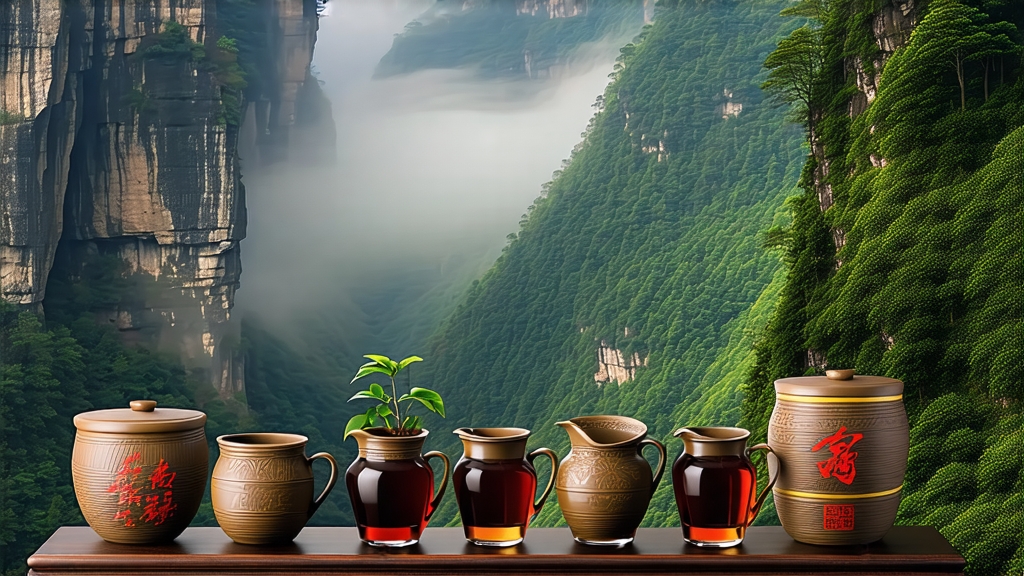
If green tea is the dewy youth of Chinese tea and pu-erh its meditative old age, then Da Hong Pao—literally “Big Red Robe”—is the dramatic aria that bridges earth and sky. Hailing from the vertiginous basalt cliffs of Mount Wuyi in northern Fujian, this rock oolong (yancha) carries within each curled leaf the crunch of mineral-rich soil, the echo of Sung-dynasty poets, and the smoke of a centuries-old charcoal fire. To international drinkers who have only met oolong in a suburban boba cup, Da Hong Pao offers a passport to a wilder, deeper China—one where tea is quarried as much as grown, and where a single sip can taste like drinking a stone that once sang.
-
Myth & History: how a Ming emperor’s cloak dyed the mountain red
Legend dated 1385 says that a Ming court scholar, stricken with dysentery while traveling to the capital, was saved by monks who brewed leaves from six scraggly bushes clinging to a crevice above the Nine-Dragon Gorge. Upon recovery the scholar topped the bushes with his crimson imperial robe to shield them from frost; the grateful emperor later sent more red silk to wrap the rocks, decreeing that the tea henceforth be tribute. Whether apocryphal or not, the story secured Da Hong Pao’s place among China’s “Ten Famous Teas,” and the original mother trees—still alive on Tianxin Rock—were guarded by soldiers well into the 2000s. Cuttings taken in the 1980s created the “queen clone” gardens that now supply most authentic Wuyi yancha, so today’s drinkers can taste the bloodline without plundering the venerable six. -
Terroir: why “rock bone and floral heart” cannot be faked
Mount Wuyi is a 550-million-year-old rift valley whose volcanic tuff has weathered into shallow, mineral-saturated shelves. Tea roots must fracture stone to survive, storing calcium, potassium and rare earths that translate into the coveted “yanyun”—a tingling, limestone-like finish that Chinese tasters call “rock bone.” Morning fog rising from the Jiuqu (Nine-Bend) River refracts sunlight, slowing photosynthesis and concentrating aromatic precursors. The microclimate is so unique that UNESCO listed the core 60 km² as a World Heritage mixed site; move the same cultivar 20 km downhill and the brew becomes pleasant but anonymous. -
Cultivars: navigating the Da Hong Pao family tree
True Da Hong Pao is not a single plant but a stylistic summit reached by three genetic paths:
a) Beidou #1 & #2—direct clones of the mother trees, prized for cold cliff air and cinnamon-spice notes.
b) Qidan, a 1980s offspring that amplifies cocoa and orchid.
c) The “commercial blend” (shipin DHP) that marries 3–5 Wuyi cultivars such as Rougui (cassia), Shui Xian (narcissus) and Tieluohan (Iron Arhat) to recreate the mother-tree profile in bulk. Purists chase single-clone lots; pragmatists embrace the blend for consistency. Both are legitimate as long as leaf originates within the 70-hectare “Zhengyan” core reserve. -
Craft: the sixteen-hour odyssey from cliff to cup
Da Hong Pao is the most labor-intensive tea in China. Picking occurs only in late April when three half-mature leaves and a dormant bud form the “zhongkai” standard. The pluck must reach the village workshop before noon to catch the mountain chill that preserves green enzymes. There it undergoes:
• Withering on bamboo racks in direct cliff wind for 30 minutes, then on water-heated troughs (60 °C) for another 90—an oscillation that jump-starts oxidation.
• Yaoqing: a rhythmic shaking in rattan drums every 20 minutes for 6–8 hours; bruising edges turn crimson while veins stay green, creating the signature “green leaf with red border.”
• Shaqing: a 280 °C wok roast for 7 minutes that halts oxidation at 30–40 %, locking in floral